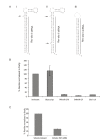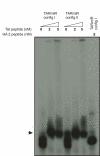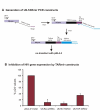A dual function TAR Decoy serves as an anti-HIV siRNA delivery vehicle
- PMID: 20144240
- PMCID: PMC2836314
- DOI: 10.1186/1743-422X-7-33
A dual function TAR Decoy serves as an anti-HIV siRNA delivery vehicle
Abstract
The TAR RNA of HIV was engineered as an siRNA delivery vehicle to develop a combinatorial therapeutic approach. The TAR backbone was found to be a versatile backbone for expressing siRNAs. Upon expression in human cells, pronounced and specific inhibition of reporter gene expression was observed with TARmiR. The resulting TARmiR construct retained its ability to bind Tat and mediate RNAi. TARmiR was able to inhibit HIV gene expression as a TAR decoy and by RNA interference when challenged with infectious proviral DNA. The implications of this dual function therapeutic would be discussed.
Figures




Similar articles
-
Lentiviral-mediated delivery of combined HIV-1 decoy TAR and Vif siRNA as a single RNA molecule that cleaves to inhibit HIV-1 in transduced cells.Nucleosides Nucleotides Nucleic Acids. 2005;24(5-7):431-4. doi: 10.1081/ncn-200059981. Nucleosides Nucleotides Nucleic Acids. 2005. PMID: 16247965
-
Inhibition of HIV-1 replication by long-term treatment with a chimeric RNA containing shRNA and TAR decoy RNA.Antiviral Res. 2009 Aug;83(2):156-64. doi: 10.1016/j.antiviral.2009.04.008. Epub 2009 May 3. Antiviral Res. 2009. PMID: 19397929
-
Inhibition of HIV-LTR gene expression by oligonucleotides targeted to the TAR element.Nucleic Acids Res. 1991 Jun 25;19(12):3359-68. doi: 10.1093/nar/19.12.3359. Nucleic Acids Res. 1991. PMID: 2062653 Free PMC article.
-
Discoveries of Tat-TAR interaction inhibitors for HIV-1.Curr Drug Targets Infect Disord. 2005 Dec;5(4):433-44. doi: 10.2174/156800505774912901. Curr Drug Targets Infect Disord. 2005. PMID: 16535863 Review.
-
HIV-1 inactivation by nucleic acid aptamers.Front Biosci. 2006 Jan 1;11:89-112. doi: 10.2741/1782. Front Biosci. 2006. PMID: 16146716 Review.
Cited by
-
Aptamers as targeted therapeutics: current potential and challenges.Nat Rev Drug Discov. 2017 Mar;16(3):181-202. doi: 10.1038/nrd.2016.199. Epub 2016 Nov 3. Nat Rev Drug Discov. 2017. PMID: 27807347 Free PMC article. Review.
-
RNA interference approaches for treatment of HIV-1 infection.Genome Med. 2015 May 28;7(1):50. doi: 10.1186/s13073-015-0174-y. eCollection 2015. Genome Med. 2015. PMID: 26019725 Free PMC article.
-
A recombinant adenoviral vector with a specific tropism to CD4-positive cells: a new tool for HIV-1 inhibition.Drug Deliv Transl Res. 2022 Oct;12(10):2561-2568. doi: 10.1007/s13346-021-01109-y. Epub 2022 Jan 31. Drug Deliv Transl Res. 2022. PMID: 35098492
-
Inhibition of HIV-1 by a Lentiviral Vector with a Novel Tat-Inducible Expression System and a Specific Tropism to the Target Cells.Hum Gene Ther. 2015 Oct;26(10):680-7. doi: 10.1089/hum.2015.031. Epub 2015 Aug 6. Hum Gene Ther. 2015. PMID: 26077977 Free PMC article.
References
-
- Bahner I, Kearns K, Hao QL, Smogorzewska EM, Kohn DB. Transduction of human CD34+ hematopoietic progenitor cells by a retroviral vector expressing an RRE decoy inhibits human immunodeficiency virus type 1 replication in myelomonocytic cells produced in long-term culture. J Virol. 1996;70:4352–4360. - PMC - PubMed
-
- Plavec I, Agarwal M, Ho KE, Pineda M, Auten J, Baker J, Matsuzaki H, Escaich S, Bonyhadi M, Bohnlein E. High transdominant RevM10 protein levels are required to inhibit HIV-1 replication in cell lines and primary T cells: implication for gene therapy of AIDS. Gene Ther. 1997;4:128–139. doi: 10.1038/sj.gt.3300369. - DOI - PubMed
Publication types
MeSH terms
Substances
Grants and funding
LinkOut - more resources
Full Text Sources
Medical

